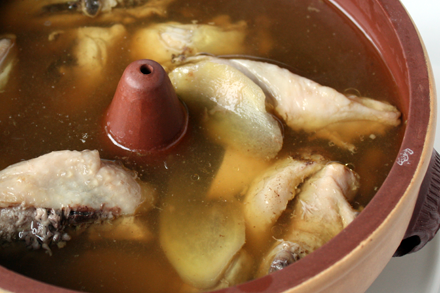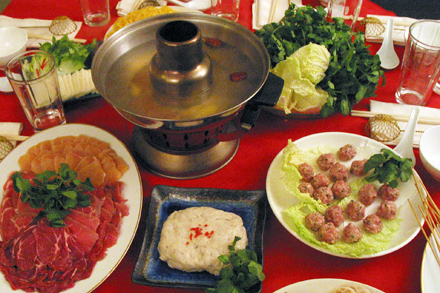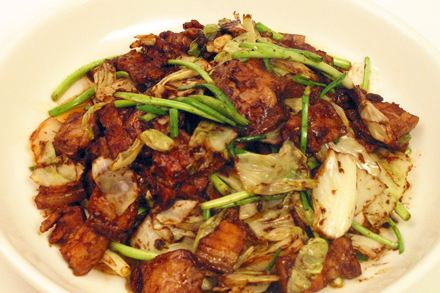I came across an article in yourcookingtips.com called “The Four Schools of Chinese Cooking.” It is one of the most blatantly misinformed articles about Chinese cooking styles.
First of all regional Chinese cooking is much more diversified than the four regions mentioned. The universally accepted classification in China for regional cooking is divided into eight cuisines (中華八大菜系): Lu (魯 Northeast China), Hui (徽 Anhui), Su (蘇 Jiangsu), Zhe (浙 Zhejiang), Yue (粵 Guangdong or Canton), Min (閩 Fujian), Chuan (川 Sichuan) and Xiang (湘 Hunan). Additionally I pointed out in one of my earlier blog post that the eight regional cuisines only represent the ethnic Han (漢) Chinese cooking. This classification does not even include the Xinjiang, Tibet, Mongolian and other minority regions. Therefore it is inaccurate to characterize Chinese cooking in only the four directional regions. Doing so will only result in very broad and general groupings.
It is this broad generalization that caused the article to suggest Muslim influence in the Northern Chinese school of cooking. It should be pointed out that the only predominantly Muslim region in the North is in Xinjiang, which is more Northwestern than Northern geographically. It is inaccurate to summarize the cooking of Beijing, for example, as being influenced by the Muslim. Beijing is the capital of the current government and the last two Chinese dynasties: Ming (明) and Qing (清). The Ming dynasty ruler’s origin was from the coast near the Yangtze River Delta, and the Qing dynasty’s ruler was from the Manchu region in the Northeast. Therefore Beijing cooking is mostly influenced by Su, Zhe and Lu cuisine of those regions.
Furthermore the discussion of Southern cooking does not include Min cuisine, which is from Fujian province. It has a very distinct cooking style and utilizes the abundance seafood from the region and should be classified as a distinct cuisine.
Yue, or Cantonese, cooking is generally considered to be the most refined of Chinese cooking rather than the Northern cooking of Beijing as noted by the article. Canton (or Guangzhou) region has been a trading center since Han (漢) dynasty around first century B.C. Therefore the cooking of the region has evolved, and been influenced not only by the local tradition but also by foreigners, for more than two thousands years. Hence Yue cooking has always been considered the most sophisticated of Chinese cooking.
Another point I’d like to bring up is that the Chuan (Sichuan) and Xiang (Hunan) cooking are two distinct styles. Although they are both characterized by hot spicy chili in their cooking, Chuan (Sichuan) cooking is associated with a hot and numbing sensation, known as “mala” (麻辣), from the combination of Sichuan pepper (花椒) and chili. Xiang (Hunan) cooking on the other hand is known for its spiciness from chili and tanginess from pickles.
I am continually amazed at the ignorance of Chinese cooking in America. I wish food writers in America could be more responsible in their writing and research of Chinese cooking before publication.





Good points; I wish Chinese restaurants in particular would identify more with a region. Any idea how the idea that there had to be a certain number of distinct Chinese cuisines came about? I wonder if people would try to classify the cuisines of India or Italy in a similar way, for example.
You can learn a little about Chinese food and think that you know an awful lot. In general though I sympathize with the western food writer trying to make sense of Chinese food through the language and cultural barriers. While the regional characteristics make Chinese cuisine more glorious and varied, they also add to the complexity of understanding the cuisine – two dishes with the same name in two different areas of China can be completely different and the foreign food writer is not always aware of all the factors that characterize their culinary experience.
I do agree that it is very difficult for Western food writers to learn the nuances in regional Chinese cooking. It is true that the language and cultural barriers are difficult to break. Although I sympathize with the difficulty in the writers’ efforts to share knowledge in Chinese cooking, I am frustrated with those who take upon themselves as experts to disseminate misinformation. The least they could do is to research the subject a little better. There is indeed reliable information on Chinese cooking in English available in print or on-line, albeit limited at this point in time.
Regional cooking style is a legitimate approach for differentiating local influence in cooking. My concern is in over generalization and inaccurate classification.
Cantonese food is also considered the most sophisticated because of the variety and abundance of produce and seafood you can get locally. Beijing’s school of cooking just can’t compare. For writers to say that Beijing’s “imperial” cuisine is more sophisticated would be like saying French cuisine is more sophisticated than Italian because it’s more associated with the aristocracy.
I agree with the idea that language is a huge barrier. I can think of maybe one Western writer who, without being at least conversational in Mandarin or Cantonese, can accurately write about Chinese food.
It’s quite common for Chinese cooking to be split into those four styles – Chines _and_ Non-Chinese writers have been doing it for years. That’s not to say the cooking cannot be divided further, however. Having said that, from what I’ve heard from people in China, regions are struggling to keep their regional specialties anyway.
There was an interesting book review in the Times Book Review today (3/9) that relates to Chinese food in the U.S. and its authenticity. Kian, I hope you’ll comment on it. I’d love to hear your take.
Very nice blog – I found it via BlogHer.
As for your lament about the ignorance of Chinese food in America, it could be broadened to ‘the ignorance of Asian food’. I’ve read so many articles on various SE Asian cuisines with glaring errors that make me cringe. It is, unfortunately, very easy for (SOME) writers to pitch themselves as experts without having the knowledge to back it up. Most publications don’t fact-check so the editor is left taking the writer’s words as face value. The best caveat is – reader beware.
I’m enjoying your site very much, and learning much, and getting some great ideas to improve my asian cooking – thanks.
Just a few observations: the site you note above (yourcookingtips.com) is not a serious site – it is one of those sites created in the hope of gathering enough hits to garner a few $ in advertising revenue, and by stealing material, therefore there is no concern re the quality of content. It also shows evidence of having been sabotaged, and with no attempt at correction by its creators. Additionally, the author of the article you note is NOT an American, although they may very well be guilty of the charges you level. I guess my point is that you can and should find a more legitimate example to underline your point – a point that is universally true!
I am working with a chef in Houston to present a Ming period dinner. It has to be very special. Could you give me some feedback on the structure and dishes for the meal, please?